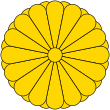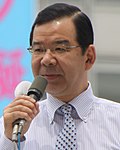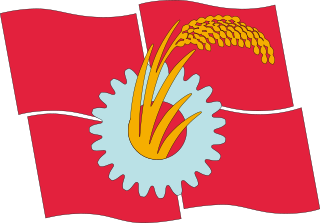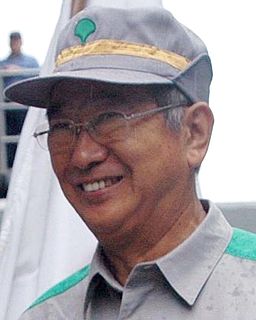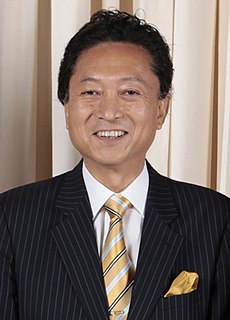
A general election for the Japanese House of Representatives was held on August 30, 2009. The opposition Democratic Party (DPJ) defeated the ruling coalition in a sweeping victory, winning 221 of the 300 electoral districts and receiving 42.4% of the proportional block votes for another 87 seats, a total of 308 seats to only 119 for the LDP.

Tokyo 18th district is a constituency of the House of Representatives in the Diet of Japan. It is located in western Tokyo and consists of the cities of Musashino, Koganei and Fuchū. Until 2002, it included Mitaka instead of Fuchū. As of 2016, 436,338 eligible voters were registered in the district.
Gunma 1st district is a constituency of the House of Representatives in the Diet of Japan. It is located in Gunma Prefecture and consists of the cities of Maebashi, Numata, parts of Kiryū and Shibukawa as well as the Seta and Tone districts. As of 2012, 387,120 eligible voters were registered in the district.
Wakayama 3rd district is a constituency of the House of Representatives in the Diet of Japan. It is located in Wakayama Prefecture and consists of Arida, Gobo, Shingu, and Tanabe cities and the Arida, Hidaka, Higashimuro, and Nishimuro districts. As of 2012, 298,296 eligible voters were registered in the district.

Aichi 5th district is a constituency of the House of Representatives in the Diet of Japan. It is located in Aichi Prefecture and consists of Nagoya's Nakamura and Nakagawa wards, the cities of Kiyosu and Kitanagoya and the Nishikasugai district. As of 2016, 428,423 eligible voters were registered in the district. The current representative of this district is Vice Speaker Hirotaka Akamatsu of the Constitutional Democratic Party.

Tokyo 1st district is a constituency of the House of Representatives in the Diet of Japan. It is located in eastern mainland Tokyo and covers central parts of the former city of Tokyo. The district consists of the wards of Chiyoda, Minato and Shinjuku. As of 2016, 514,974 eligible voters were registered in the district.
Aichi 6th district is a constituency of the House of Representatives in the Diet of Japan. It is located in Northwestern Aichi and consists of the cities of Kasugai, Inuyama and Komaki, part of the Chūkyō Metropolitan Area around Nagoya. As of 2012, 420,807 eligible voters were registered in the district.
Kyōto 3rd district is a constituency of the House of Representatives in the Diet of Japan. It is located in South central Kyoto and consists of Kyoto city's Fushimi ward, the cities of Mukō and Nagaokakyō and the town of Ōyamazaki. As of 2012, 345,260 eligible voters were registered in the district.
Hyogo 11th district is a constituency of the House of Representatives in the Diet of Japan. It is located in Southwestern Hyōgo and is based on the 1995 borders of the city of Himeji; the former towns of Ieshima, Yumesaki, Kōdera and Yasutomi that merged into Himeji in 2006 are part of the 12th district. As of September 2015, 387,509 eligible voters were registered in the district.

Hokkaidō 5th district is a constituency of the House of Representatives in the Diet of Japan. It consists of Atsubetsu ward in Hokkaido's city of Sapporo and Ishikari Subprefecture without Sapporo. As of 2009, 453,752 eligible voters were registered in the district.
The Shikoku proportional representation block is one of eleven proportional representation (PR) "blocks", multi-member constituencies for the House of Representatives in the Diet of Japan. It consists of Shikoku region covering Tokushima, Kagawa, Ehime and Kōchi Prefectures. Following the introduction of proportional voting it elected seven representatives in the 1996 general election. When the total number of PR seats was reduced from 200 to 180, the Shikoku PR block shrunk to six seats.

Kanagawa 1st district is a single-member constituency of the House of Representatives, the lower house of the national Diet of Japan. It is located in eastern Kanagawa Prefecture and covers the central downtown and southeastern parts of the prefectural capital of Yokohama, namely the Naka (centre), Isogo and Kanazawa wards. It is among many other things home to the Yokohama city hall and the Kanagawa prefectural government building. As of 2012, 420,153 eligible voters were registered in the district.

Yamaguchi 4th district is a single-member electoral district for the House of Representatives, the lower house of the National Diet of Japan. It is located in Western Yamaguchi and consists of the cities of Shimonoseki and Nagato. As of September 2011, 266,456 voters were registered in the district, giving its voters well above average vote weight. Unlike many prefectures where the capital is also the most populous city, Yamaguchi's major city is Shimonoseki, located at the western tip of Honshū and part of the Fukuoka-Kitakyūshū metropolitan area.
Kumamoto 4th district is a current single-member electoral district for the House of Representatives, the lower house of the National Diet of Japan. It is located in Kumamoto and since 2017 covers roughly the Southern half of Kumamoto.

Yamaguchi 1st district is a single-member electoral district for the House of Representatives, the lower house of the National Diet of Japan. It is located in Yamaguchi and covers the prefectural capital Yamaguchi, parts of the city of Shūnan and the city of Hōfu. As of September 2012, 359,151 eligible voters were resident in the district.

Hokkaidō 2nd district is a single-member electoral district for the House of Representatives, the lower house of the National Diet of Japan. It is located in the prefecture (-dō) of Hokkaidō and consists of two wards (-ku) of the prefectural capital, the city (-shi) of Sapporo: Kita ("North") and Higashi ("East"). As of 2013, 444,440 eligible voters were registered in the district.

The 24th regular election of members of the House of Councillors was held on Sunday 10 July 2016 to elect 121 of the 242 members of the House of Councillors, the upper house of the 717-member bicameral National Diet of Japan, for a term of six years. As a result of the election, the LDP/Komeito coalition gained ten seats for a total of 146, the largest coalition achieved since the size of the house was set at 242 seats.
The Shikoku proportional representation block was one of 11 multi-member districts that were contested at the general election for the House of Representatives in the Japanese National Diet on 14 December 2014. Six seats were available for election via open party lists. Prime Minister Shinzo Abe's Liberal Democratic Party (LDP) maintained their dominance in the predominantly rural area, claiming three of the seats.
A by-election for the Kyoto-3rd seat in the Japanese House of Representatives was held on 24 April 2016, coinciding with the by-election in Hokkaido. The seat became vacant after sitting member Kensuke Miyazaki resigned on 12 February 2016 in the midst of an extramarital affair scandal. Miyazaki, a member of the Liberal Democratic Party, served the district from 2012. He defeated Democratic Party MP Kenta Izumi by slim margins in the 2012 (0.1%) and 2014 (2.7%) elections.

Prefectural elections for the Tokyo Metropolitan Assembly were held on 2 July 2017. The 127 members were elected in forty-two electoral districts, seven returning single members elected by first-past-the-post, and thirty-five returning multiple members under single non-transferable vote. Four districts had their magnitude adjusted in this election to match population changes.

